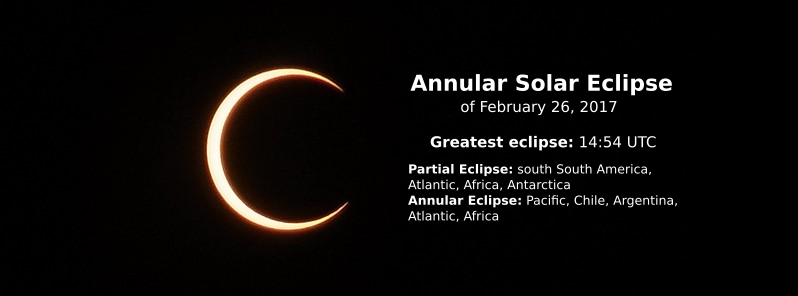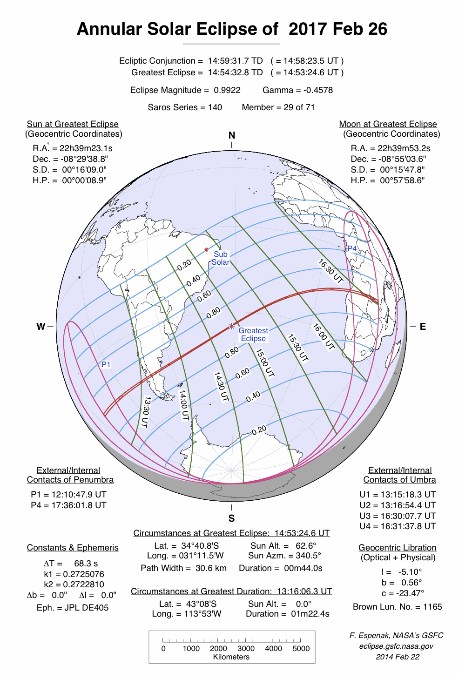Annular solar eclipse of February 26, 2017

An annular solar eclipse will take place on February 26, 2017, creating a ring of light around the darkened Moon as the Moon will be too far away from the Earth to completely cover the Sun. This is the first of two eclipses in 2017 and comes just 7 months before the first transcontinental American eclipse in a century.
The path of this month's eclipse will begin off the coast of Chile and pass through southern Chile and southern Argentina, across the southern Atlantic Ocean, and into Angola and Congo in Africa. A partial eclipse will be visible throughout parts of southern South America and southwestern Africa.
The instant of greatest eclipse will take place at 14:54 UTC, 4.7 days before the Moon reaches perigee. During the eclipse, the Sun is in the constellation Aquarius.

This eclipse belongs to Saros 140 and is number 29 of 71 eclipses in the series, according to Fred Espenak, NASA's eclipse expert.
All eclipses in this series occur at the Moon’s descending node. The Moon moves northward with respect to the node with each succeeding eclipse in the series and gamma increases.
The synodic month in which the eclipse takes place has a Brown Lunation Number of 1165.
The next solar eclipse will be a total one and will take place on August 21, 2017. It will be a rare opportunity for 300 million Americans to experience a total eclipse of the Sun right at home.
Watch it live
Slooh will provide live coverage of this event, joined by solar scientists, Slooh astronomers, and cultural experts to help bring a deeper understanding to Solar Eclipses and their place in the larger culture of mankind. They will talk about the role the moon plays in eclipses, and how this is the only time we ever truly get to see a New Moon.
The streaming begins 12:00 UTC (07:00 EST).
Links
- Orthographic Map: Annular Solar Eclipse of February 26, 2017 – detailed map of eclipse visibility
- Animated Map: Annular Solar Eclipse of February 26, 2017 – animated map of the Moon's shadows across Earth
- Google Map: Annular Solar Eclipse of February 26, 2017 – interactive map of the eclipse path
- Path Table: Annular Solar Eclipse of February 26, 2017 – coordinates of the central line and path limits
- Circumstances Table: Annular Solar Eclipse of February 26, 2017 – eclipse times for hundreds of cities
- Saros 140 Table – data for all eclipses in the Saros series
Featured image credit: Toshiyuki Imai. Edit: TW

Did we not just recently have Super Moons, closest moon to earth relation in it’s orbit? How does the moon go from closest to, and then a couple months later, be so far from earth that it won’t make a full eclipse?
Just asking.